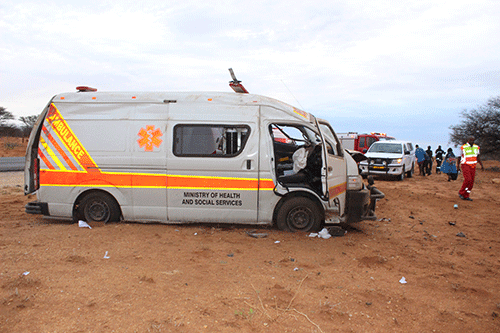More and more health facilities continue to operate without the emergency services of an ambulance countrywide – a situation putting the lives of many patients at risk as they can’t access medical attention on time. This state of affairs was revealed by the National Council’s standing committee on health, social welfare and labour affairs, which found out that all regions face the serious challenges of transport in the health sector.
For instance, in the Hardap region, at the Mariental district hospital to be specific, only eight out of 17 ambulances are operational.
Most of the clinics in the region do not have ambulances, despite the vast distances between them and the Mariental district hospital.
Health workers indicated to the committee that the mini-buses that have been modified or converted into ambulances always give problems, as they are mostly used on gravel roads and wear off easily. Due to the unavailability of ambulances at the Aranos hospital, relatives are being advised to take patients to the hospital themselves.
The standing committee undertook
oversight visits to the //Kharas, Hardap and Omaheke regions from 8 to 18 March 2022; while the Kunene, Omusati and Ohangwena regions were visited from 3 to 10 October 2022. The committee also visited the Oshana, Oshikoto, Otjozondjupa and Erongo regions from 22 January 2023 to 4 February 2023.
During the site visits, the committee observed many broken ambulances and other vehicles parked around most health facilities.
Reacting to the report, Landless People’s Movement (LPM) councillor for Berseba, Jeremias Goeieman, last week said in the National Council that the issue of a lack of ambulances is a big problem everywhere.
“Sometimes when you phone for an emergency, you will be informed that the driver is on leave, and there is no substitute driver. In Berseba, the driver went on retirement last year in August, but he has not been replaced yet. You are sitting some 100km away where you are stuck, and the driver must come from Keetmanshoop to come for the emergency. This is a vast constituency. When people are discharged from hospital, they are dropped at the tarred road to see for themselves; even those coming from the maternity ward with small babies,” he lamented.
He proposed that the health ministry trains and equips community health officials on conducting first aid in case of an emergency while waiting for an ambulance to arrive from Keetmanshoop, some 124km away. Aminius constituency councillor Peter Kazongominja also narrated the ambulance woes in his constituency, which is some 250km away from the Gobabis referral hospital, where an ambulance is stationed.
“During December, I was called that we have two patients at Corridor 13, but there was no ambulance. There was another patient at Leonardville, and another one at Aminius, but there was no ambulance either. We had to arrange with our office’s car to pick up the one patient at Aminius and two at Corridor 13. But the older patient didn’t make it and passed on because of the lack of an ambulance,” he said. Katutura East constituency councillor Richard Gaoseb confirmed that most ambulances are grounded at health facilities.
“My million-dollar question is: since we have so much unemployment in this country, what is so difficult to make use of VTCs’ graduates to fix these ambulances? These graduates are qualified. Why doesn’t the ministry of health use these guys? Some of the issues are not technical – you find that some ambulances just need a battery replacement, but you find that Windhoek must decide on which type of battery to buy, and this hampers development in the region,” he stressed.
The standing committee found that the Ohangwena region has both sandy and rocky terrains, and requires suitable 4×4 vehicles.
The Hardap region equally struggles with slippery roads during the rainy season. All regions visited registered their frustration with the lack of ambulances and drivers.
Some hospitals indicated that they were given normal double-cab bakkies as ambulances. Unfortunately, these cars are not fitted with any medical equipment or life support equipment which will help patients during transportation.
A classic example was given in the Omaheke region, where the health workers had to transport a patient with a broken leg to the Gobabis district hospital. The patient could not fit into the car without causing further
damage to his already-broken leg.
The committee observed that most visited regions had maternal waiting shelters to accommodate expectant mothers residing far from health facilities. The waiting shelters were constructed by the health ministry, in partnership with private donors. The regional councils also play a critical role in making sure that the services are subsidised and the shelters are well-looked-after. In the Oshana region, a shelter (wapandula) exists, and discussions are currently underway to establish who should be responsible for managing it, whereas the Omuthiya district hospital indicated their need for a maternity shelter. It was further observed that the waiting shelters were in good physical condition, with the exception of the Ohangwena shelter, which needs to be renovated
The committee was informed that at some shelters, mothers were contributing as little as N$14 per week, but some mothers could unfortunately still not afford to pay.
–anakale@nepc.com.na


